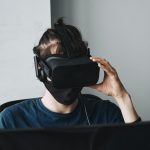VR, a phenomenon that changed the manner in which individuals view and use all technology. From the way kids were able to play games, to the way doctors were able to practice life saving surgeries. All technology becomes accessible in some point of their existence; as seen through computers which used to be exclusively owned by the wealthy, to present days, where the functions of a computer are found in every smart device. VR headsets are following in these footsteps as the device is becoming smaller within 5 years, possibly, everyone could be owning one. So let’s explore the history of the revolutionary device, and where it could end up.

1960s
Morton Heilig created and patented the Sensorama Simulator . The device was similar to the size and shape of a booth, where the user had to place their head inside the machine in order to experience a variety of senses.
This idea then gradually developed into the first virtual reality HMD (head-mounted device), created by Ian Sutherland and Bob Sproull. This device was created to connect to a computer instead of a camera, which was a massive step forward for VR technology. The device was able to track the user’s movement, altering perspective accordingly. Sadly, this project never left the lab as it never became comfortable or usable for potential users.

1970s
After Heilig’s, Sutherland’s and Sproull’s efforts the American military took an interest in this technology and began applying it to flight simulators. The most notable example of this is by the General Electric Corporation who created a computerised flight simulator that contained a 180-degree spectrum of vision. This was furthered by the McDonnell-Douglas Corporation who placed a head tracker in the HMD in order to follow the eyes movements, to create a more realistic simulation.
While some organisations/individuals were focusing on expanding the simulation itself, others were concentrating on making it more social. VIDEOPLACE, created by Kruger, was an experience that could be used through the combination of projectors, video cameras, video displays and position sensitive technology, and did not need goggles or other accessories (Campbell, 2017). Ultimately, surrounding the user in VR.

1980s
Stereo vision glasses by StereoGraphics, is the most similar to the way VR devices look in present times, was created . Followed by the first wired gloves by Sandin and Defanti, often known to be the beginning of gesture recognition. Simultaneously, Dimension International formulated a 3D building software for PCs creating a foundation for future VR softwares.

1990s
The first mass-produced VR entertainment system called Virtuality was born, launched by The Virtuality Group. The pod included VR headsets which showcased 3D images and could be used to play with multiple players. This headset, aesthetically, reflected the visor look because of the popular film Robocop and had built in headphones as well as sensors, which is what is included in present headsets. Near the end of this era is when the device became even more portable, as Nintendo experimented with the Virtual Boy console.

2000s (inclusive of 2010s)
The ever popular Oculus Rift began its journey with Palmer Luckey creating the initial prototype which included a never before seen 90 degree field of vision and was more computer based. Facebook then bought Oculus VR, which rapidly made the device more portable and accessible. This brought on possibilities unbeknownst to the public such as the BBC creating a 360 degree video that shows a Syrian migrant camp (Wakefield, 2015) or YesVR creating 360 degree videos that aid in the training of future employers. With all of this new found appreciation for VR, HTC released HTC VIVE which relied on sensor-tracking making it easier to move more freely.
What’s next for VR?
From the clunky Sensorama to the sleek new Oculus Quest 2, used by YesVR, VR has rapidly altered itself to become more convenient for the wider public. This is quite similar to the timeline of the mobile phone which was extremely inconvenient to carry around to existing times where individuals can not survive without the nifty little devices. Being similar to the life of mobile phones, it can be predicted that within the next 5 years VR will be in everyone’s pockets to do training on the go or to experience your favourite concerts over and over again. Whatever your need, VR is evolving to be there with you.
Written by Belinda Saha
Similar articles to check out:







